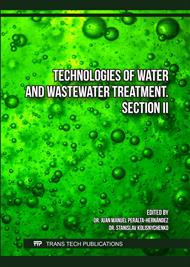[1]
A. Tripathi and M. R. Ranjan. Heavy Metal Removal from Wastewater Using Low Cost Adsorbents Bioremediation & Biodegradation. Journal of Bioremediation & Biodegration. 6(6) (2015) 1–2.
DOI: 10.4172/2155-6199.1000315
Google Scholar
[2]
S. S. Ahluwalia and D. Goyal. Microbial and plant derived biomass for removal of heavy metals from wastewater. Bioresource Technology. 98(12) (2007)2243–2257.
DOI: 10.1016/j.biortech.2005.12.006
Google Scholar
[3]
M. Hossain, H. H. Ngo, W. S. Guo and T. V. Nguyen. (2012). Biosorption of Cu (II) from water by banana peel based biosorbent: experiments and models of adsorption and desorption. Journal of Water Sustainability, 2(1) (2012) 87–104.
Google Scholar
[4]
K. Jaji, N, Man and Nawi, N. M. Factors affecting pineapple market supply in Johor, Malaysia. International Food Research Journal, 25 (2018) 366–375.
Google Scholar
[5]
S. D. Rajendran. Buyer-Supplier Relationships in Malaysian Pineapple industry Supply Chain (2013) Universiti Putra Malaysia.
Google Scholar
[6]
A. Yuris. A Comparative Study of the Antioxidant Properties of Three Pineapple (Ananas comosus L.) Varieties, 3 (2014) 40–56.
DOI: 10.5296/jfs.v3i1.4995
Google Scholar
[7]
P. D. Deshmukh. Bioremediation & Biodegradation Cadmium Removal from Aqueous Solutions Using Dried Banana Peels as An Adsorbent: Kinetics and Equilibrium Modeling. Journal of Bioremediation & Biodegradation, 8 (2017).
DOI: 10.4172/2155-6199.1000395
Google Scholar
[8]
R. Lakshmipathy. Watermelon rind as biosorbent for removal of Cd2+ from aqueous solution: FTIR, EDX, and Kinetic studies. Journal of the Indian Chemical Society (2016).
Google Scholar
[9]
T. Brahmaiah, L. Spurthi, K. Chandrika, S. Ramanaiah and K. S. S. Prasad. (2015). Kinetics of Heavy Metal (Cr & Ni) Removal from The Wastewater by Useing Low Cost Adsorbent. World Journal of Pharmacy and Pharmaceutical Sciences, 4(11)(2015), 1600–1610.
Google Scholar
[10]
N. T. Abdel-Ghani, M. Hefny and G. A. F. El-Chaghaby. Removal of lead from aqueous solution using low cost abundantly available adsorbents. International Journal of Environmental Science & Technology, 4(1) (2007) 67–73.
DOI: 10.1007/bf03325963
Google Scholar
[11]
L. Anah and N. Astrini, Influence of pH on Cr (VI) ions removal from aqueous solutions using carboxymethyl cellulose-based hydrogel as adsorbent,, in Proc. IOP Conf. Ser.: Earth Environ. Sci, (2017)1-6.
DOI: 10.1088/1755-1315/60/1/012010
Google Scholar
[12]
M. S. Rajput, A. K. Sharma, S. Sharma and S. Verma. Removal of Lead (II) from aqueous solutions by orange peel, International Journal of Applied Research, 1(9) (2015) 411–413.
Google Scholar
[13]
L. D. Barreira, P. F. Lito, B. M. Antunes, M. Otero, Z. Lin, J. Rocha and C. M. Silva. Effect of pH on cadmium (II) removal from aqueous solution using titanosilicate ETS-4, 155 (2009)728-735.
DOI: 10.1016/j.cej.2009.09.014
Google Scholar
[14]
J.S. Anwar, U. Salman, M. Dar, and S. Anwar. (2010). Bioresource Technology Removal of Pb II) and Cd (II) from water by adsorption on peels of banana. Bioresource Technology, 101(6) (2010),1752-1755.
DOI: 10.1016/j.biortech.2009.10.021
Google Scholar



